Some of the most exciting footballers in history have derived from the Eredivisie, with their youth teams being responsible for a majority of these. Denis Bergkamp, Arjen Robben, and Ruud van Nistelrooy to name just a few. But with money and success becoming increasingly more important in the game, are youngsters still given the chance to excel?
Certain academies within the Eredivisie appear to thrive, including AZ Alkmaar, Feyenoord, and most notably Ajax. The latter recently sold two academy graduates after they had influential seasons for the club: Frenkie de Jong and Matthijs de Ligt to Barcelona and Juventus respectively. Ajax reached the semi-finals of the Champions League and won the Eredivisie. The two players were sold for a collective £144.45milion, proving that youth can lead to an increase in success and money.
This data analysis will assess the use of local players in the 2019/20 Eredivisie season. Here, we define ‘local’ as a player that has been educated by the club, and subsequently, promoted to the first team. We will take a closer look at the data behind these players’ seasons, and who have been the best performers.
The Dutch way
The Eredivisie is a fair bit behind the top five European leagues in terms of money. Therefore teams rely on improving homegrown and local talent, instead of looking for players from abroad to improve their squads.
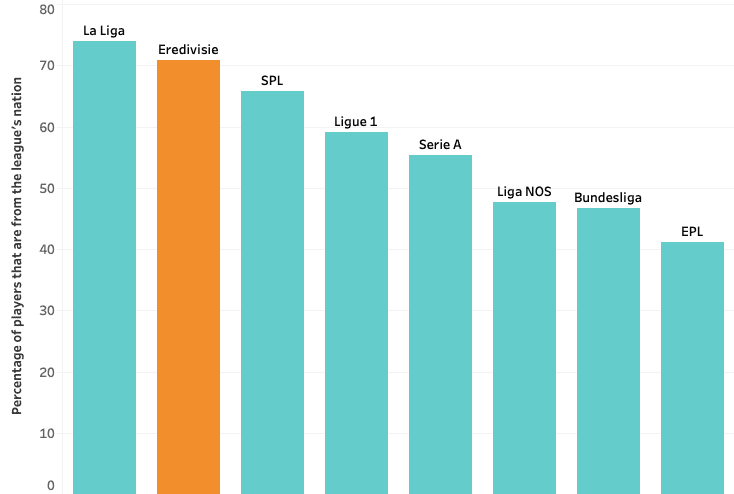
The above graph shows us what percentage of each league is occupied by players from that home nation. For example, Spanish players in Spain and so on. The statistics show that La Liga leads the way with 74.02% of the players coming from the home nation. The Premier League is often scrutinised for their lack of youth development, evident in the graph above as they are last with just 41.1%. A prime example being Manchester City‘s recent big-money buys. While Eredivisie clubs’ confidence in homegrown players is clearly shown, with 70.88% of the league’s players being Dutch.
The Eredivisie is known for its reliance on homegrown players over foreign signings. But how have the stats changed over the last few seasons as money has become more important?
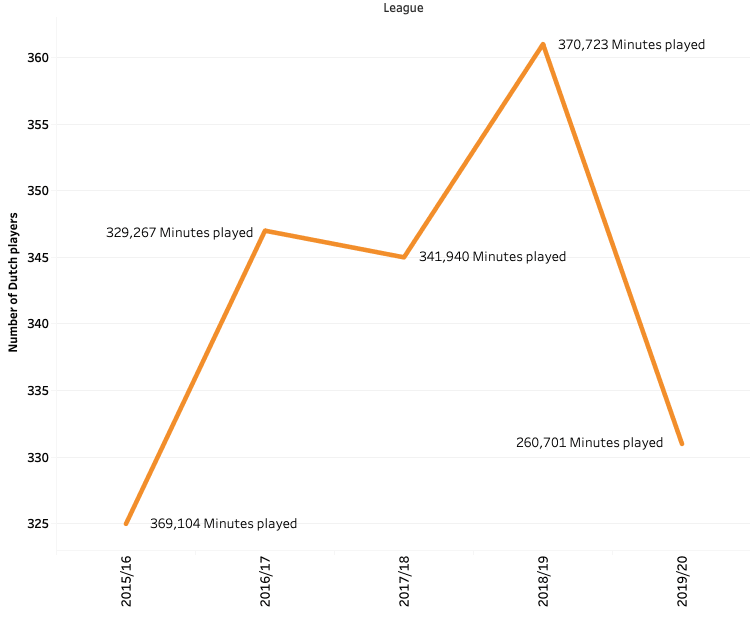
The graph shows an increase in the amount of Dutch players in squads, from 325 players in the 2015/16 season to 361 players in 2018/19. However, the financial pressure seems to have kicked in with many teams selling their best prospects, and bringing in overseas players. The 2019/20 season saw the least amount of Dutch players since 2015/16. Ajax used the money from de Jong and de Ligt to bring in Edson Álvarez (Mexican), Lisandro Martínez (Argentinian), and Razvan Marin (Romanian). Favouring quick success over promoting youth.
However, Ajax have proven that investing in youth can bring you success. But is this true for the smaller teams in the league?
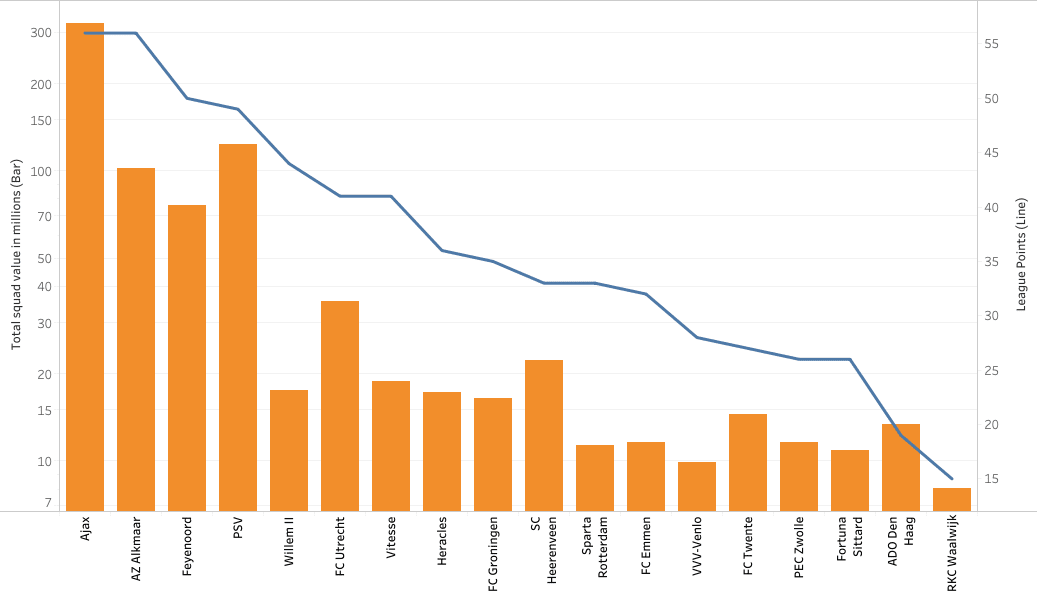
Here we can identify the four teams with the best squads in the Eredivisie, and how their squad value compares with their league position. PSV have had a disappointing season. With the second-highest squad value, they were expected to finish much higher. However, AZ and Feyenoord have used considerably more local players in their team, meaning that money does not always equal success.
Investing in local players
The Eerste Divisie has been an integral part of nurturing young players for many clubs. Eredivisie teams don’t use youth competitions to give their youngsters experience, rather, they have ‘B’ teams in the Dutch second division. Similar to the Spanish leagues, where Barcelona have a ‘B’ team. Currently, four clubs have a ‘B’ club in the second division, Ajax, AZ, Utrecht, and PSV. Using this structure, youngsters are able to test themselves against fully experienced professional footballers, instead of other players who are the same age with similar experience. It reduces the step-up from the second team to the first team.
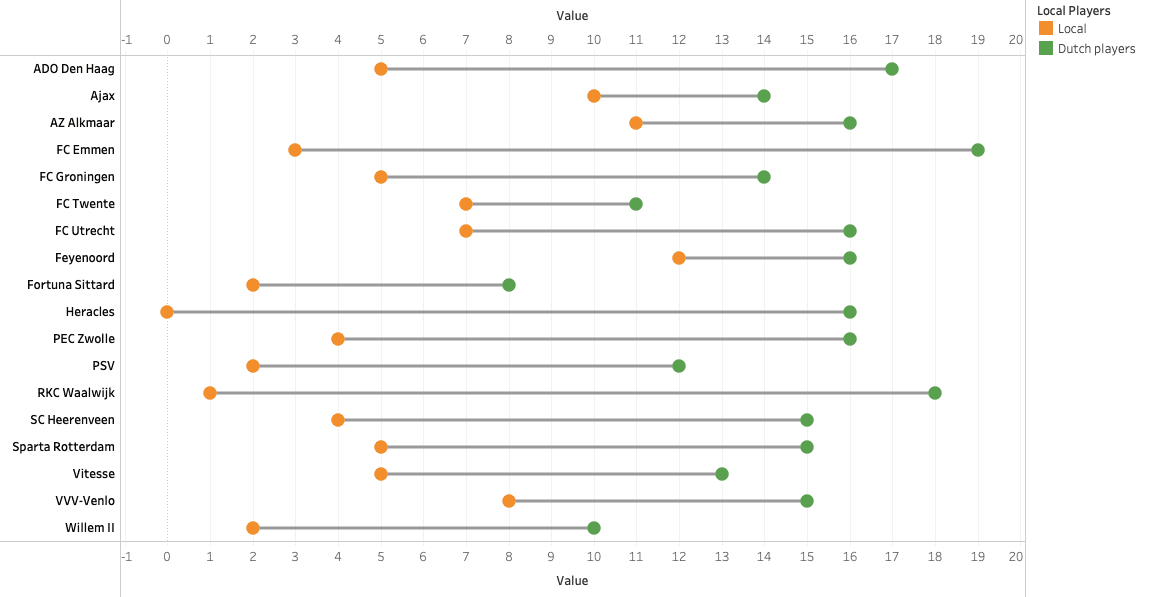
The above graph shows the number of Dutch players in each club’s squad along with the number of local players, and the difference between these. The teams with a smaller line between points tend to educate their own youngsters and promote them to the first team. Whereas teams with a longer line tend to get their youngsters from other clubs’ academies and promote them straight to their first team. Often picking up the less prosperous players.
Feyenoord lead the way with an impressive 12 local players, meaning 44.44% of their squad is made up of locals. The only team that beats this is AZ, with 45.83%. Another team investing in their local talent pool is the famous Ajax, with 35.71% of their squad being local players. These teams finished in the top three this past season as their use of local talent helped their successes.
Most disappointing is Heracles Almelo, the mid-table club doesn’t boast any local players in their squad. While PSV only had two local players in their squad this season which is disheartening for a club with so much previous success. They are clearly opting to bring other academy graduates in instead of producing their own.
Giving youth a chance
Having local young players in your squad will certainly give them a confidence boost. Being around first-team players will allow them to learn more about the game. However, this can only go so far. These youngsters must get minutes on the pitch to be able to gain experience and grow as footballers. Here, we will analyse which clubs give their local players the most opportunities to step onto the pitch, and which players get the most game-time.
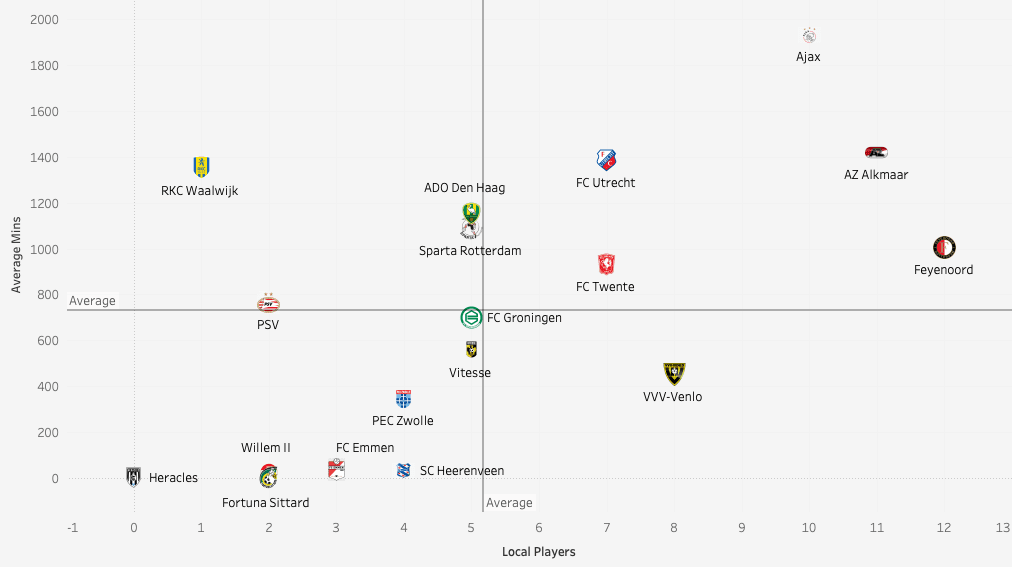
This graph shows the number of local players in each team’s squad, against the average minutes that these players have been on the pitch. Feyenoord, AZ and Ajax stand out once again. With Twente and Utrecht also appearing above the league average in both stats.
On their way to the summit of the league, Ajax gave their local players an average of 1935.60 minutes, the highest in the league. These players include Donny van de Beek, Sergiño Dest, and Jurgen Ekkelenkamp.
VVV Venlo takes up an interesting position on this graph: they have the fourth-most local players with eight, but they only have an average of 451.63 minutes each. In part, that’s because only In four of these players were given game time. But with the second-lowest squad value, they are using youth to drive the club forward.
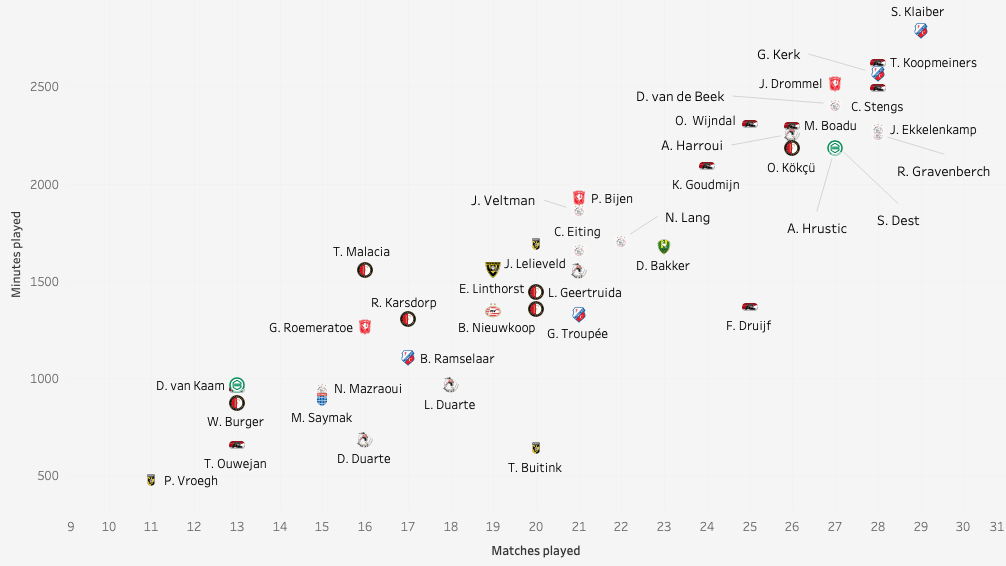
From this point in the analysis, we will be focusing on local players that are 28 or younger because many local players will come back to retire in the Eredivisie. For example, Daley Blind, Ryan Babel, and Lex Immers.
Sean Klaiber of Utrecht has played more minutes and games than anyone else. The 25-year-old has weighed in with four goals and four assists from right-back this season. Gyrano Kerk, another Utrecht player has also featured heavily. The right-winger has played 28 matches and 2566 minutes this season.
17-year-old Ryan Gravenberch and 20-year-old Ekkelenkamp have both played 28 matches, quite extraordinary considering their age, especially Gravenberch. The Ajax pair have had a huge input on the club’s success this season.
Second-placed AZ has two players high up here too. Teun Koopmeiners has played 2623 minutes, scoring 11 goals in the Eredivisie. While Calvin Stengs has played 2491 minutes, scoring 5 times and racking up 8 assists.
The top performers
As we turn to focus on individual performances and stats, we can begin to analyse whether these players are repaying their teams for giving them game time. We can use attacking, defending and passing data to determine who have been the top local performers under the age of 29 in the Eredivisie this season.
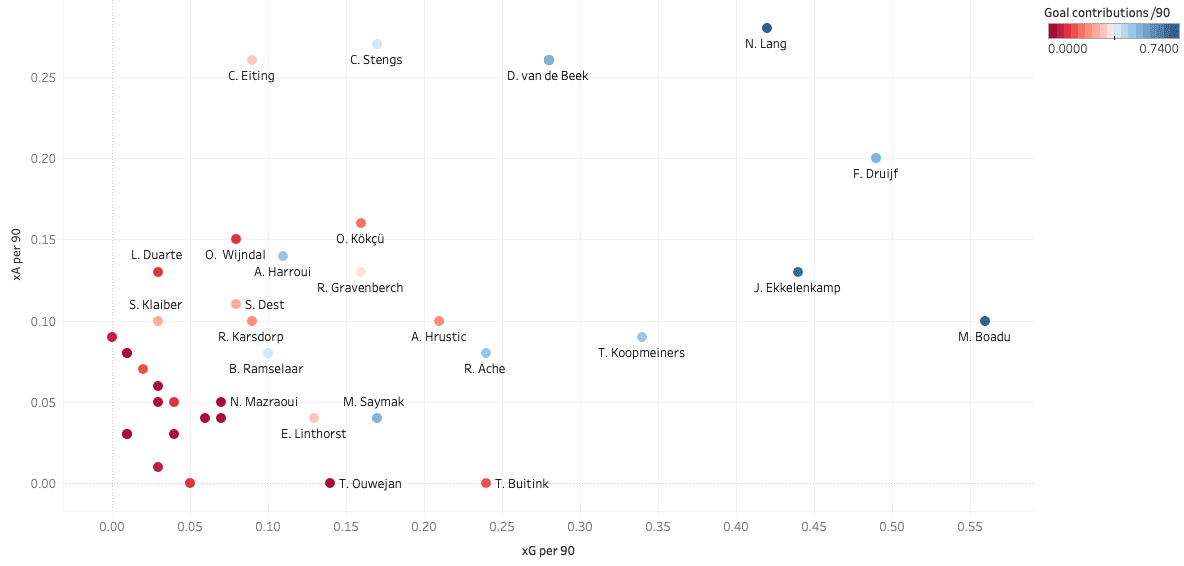
The above graph shows each player’s expected goals per 90 against their expected assists per 90. With the colour of each point signifying their actual goal contributions per 90. This helps us identify the most involved players attack-wise. Noa Lang stands out here, with the most xA per 90 (0.28) and a great xG per 90 of 0.42. Although Lang is an Ajax player, he spent last season on loan at Twente. But with these stats, he will certainly be in Ajax’s plans for the future.
Myron Boadu has the most xG per 90 with 0.56. Boadu has enjoyed a great season with AZ. The team’s defence has been heavily praised, but the 19-year-old has been emphatic at the other end of the pitch this season: scoring 14 goals in 26 games.
Donny van de Beek shows up well in both stats here. The 23-year-old has been playing a deeper role this season, but still has 0.28 expected goals and 0.26 assists per 90. Showing that he’s an all-round player.
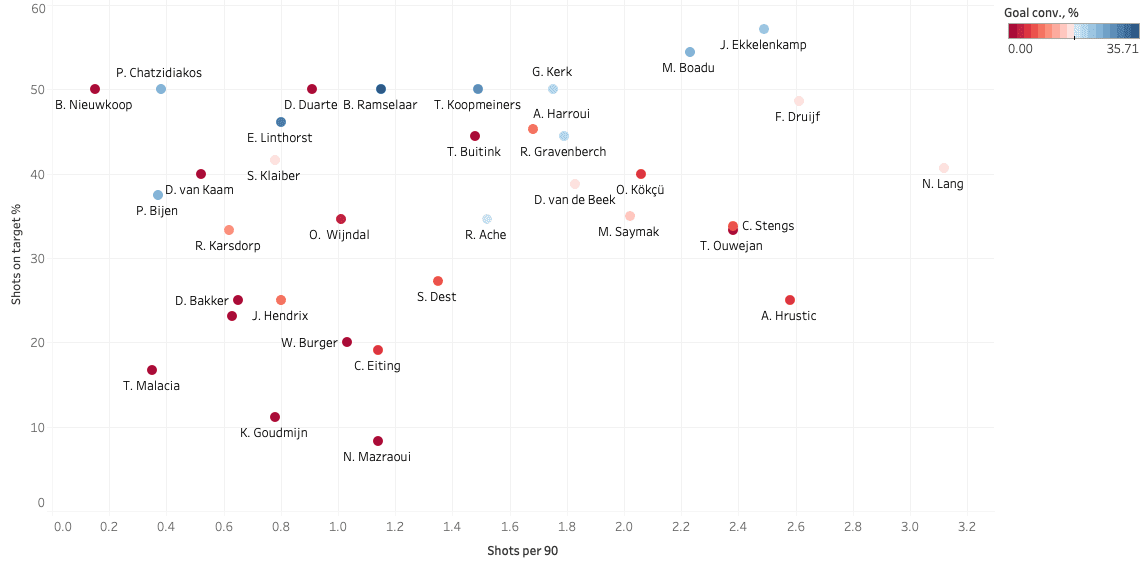
We analysed shots per 90, shots on target % and goal conversion % to find the best players in front of goal. Lang leads the way in terms of shots per 90 with 3.12 and gets 40.68% of his shots on target. However, he has a fairly average goal conversion percentage of 16.5%.
Ekkelenkamp has the best shots on target percentage with 57.14%, he takes 2.49 shots per 90 which is still quite a lot for an attacking midfielder. His frequent shots and ability to get them on target makes him an accurate shooter.
Bart Ramselaar has the best goal conversion percentage with 35.71%, he only takes on 1.15 shots per game and gets 50% of these on target. His stats show that he’s very selective in his shots, but is able to score when the opportunity arises.
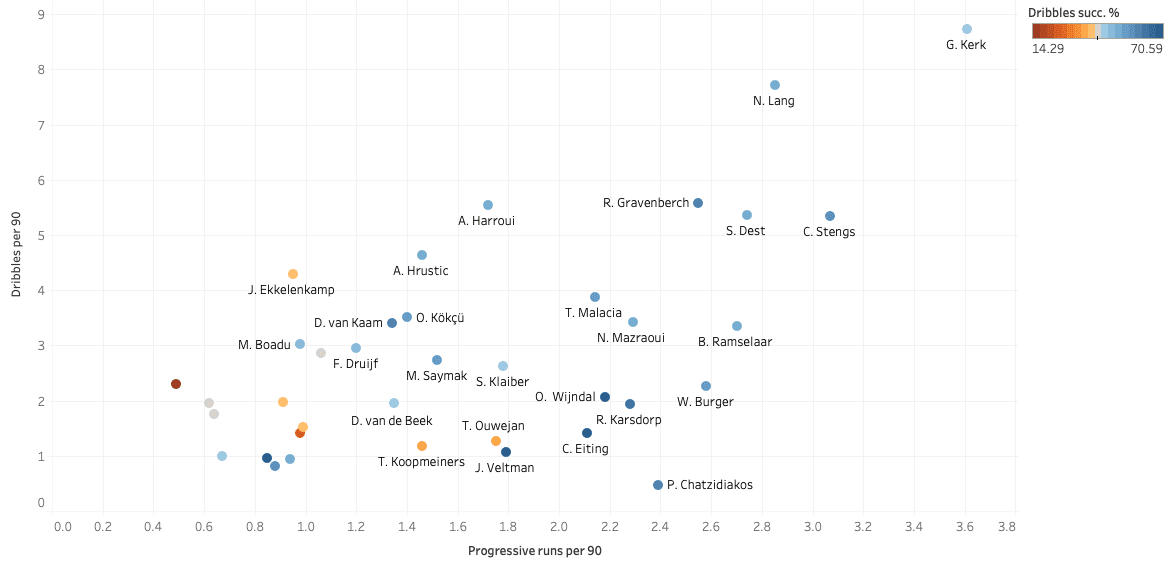
The above graph will be able to tell us which players prefer to advance through dribbling instead of playing a pass. Utrecht’s Kerk has by far the most progressive runs per 90 and dribbles per 90 with 3.61 and 8.73 respectively.
Two previously mentioned attack-minded players are also high in these areas: Lang and Stengs. Young Ajax full-back Sergiño Dest prefers to help his team out with his dribbling skills. The 19-year-old took over the right-back position from Noussair Mazraoui towards the end of last season. With Ajax favouring Dest’s work rate and attacking prowess. The young American has 2.74 progressive runs and 5.36 dribbles per 90.
Vitesse’s young right-back, Julian Lelieveld, has the best dribble success percentage with 70.59%. He only attempts 0.96 dribbles per 90 meaning he doesn’t choose this option very often, but when he does it is extremely effective.
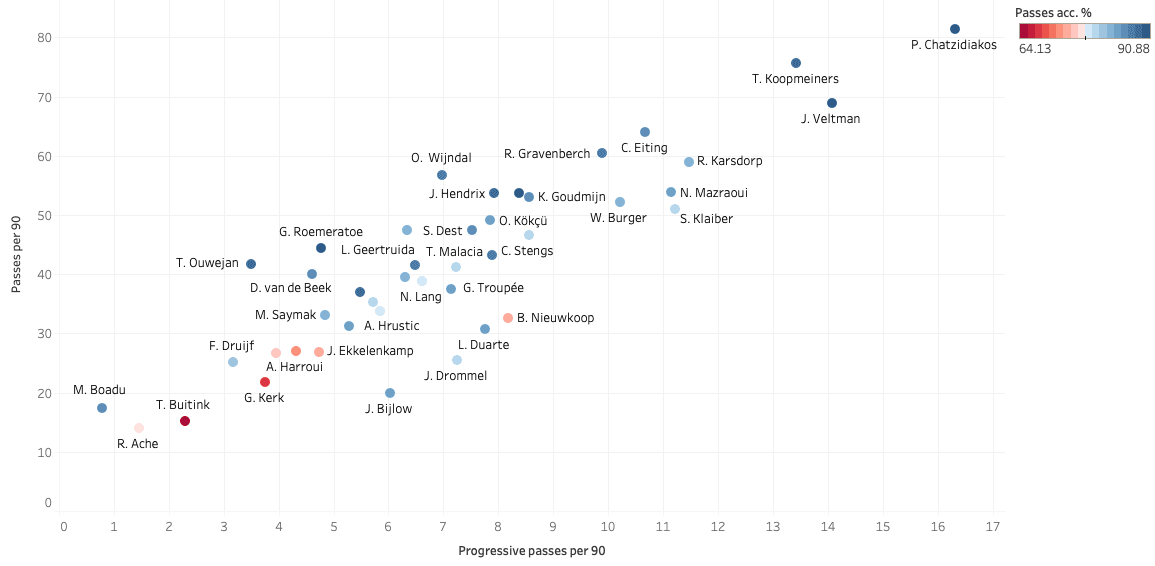
Dutch youngsters are all brought up on the same football that was made popular by the national team, focusing more on passing. Whereas in the English system, teams all play differently, making the transition into the Premier League that much harder. This graph shows the best Dutch passers.
AZ coach Arne Slot prefers a riskier style of play, passing the ball out from the back to progress up the pitch. That is why AZ defensive midfielder Koopmeiners and centre-back Pantelis Chatzidiakos perform well in these areas. Koopmeiners makes 75.72 passes per 90, with a completion rate of 88.93%, and 13.43 progressive passes per 90. Similarly, the Greek defender makes 81.41 passes per 90, with 89.57% being successful, and 16.32 progressive passes.
Another centre-back that is an accomplished passer is Ajax fan-favourite Joel Veltman. The 28-year-old makes 68.93 passes per 90, completing 90.88% of them, the best player from our sample.
Full-backs Klaiber, Mazraoui, and Rick Karsdorp all have similar stats. The latter comes out on with 58.96 passes per 90 and 11.47 progressive passes.

Interceptions per 90 and defensive duels per 90 will show us which players get in the best defensive positions to stop their opponents in their tracks.
Chatzidiakos makes the most interceptions with 6.2 per 90 minutes. Peet Bijen of Twente is also impressive in this area with 6.03 per 90.
Feyenoord’s Bart Nieuwkoop, who was on loan at Willem II this season, is even better at cutting out the ball. In fact, the right-back is the most complete player when it comes to these two categories. In 20 games, he’s involved in 10.48 defensive duels and makes 6.04 interceptions per 90. He is looking to get back into the Feyenoord team and this encouraging season will surely help him do so.
Meanwhile, Feyenoord’s current right-back, who forced Nieuwkoop out on loan, has the most defensive duels per 90 (11.3). He also weighed in with 4.12 interceptions per 90.
Conclusion
In this data analysis, we have looked at a number of Dutch players who ply their trade in their home country. Then, how football, as a business, has impacted the statistics. We then worked our way down to how Eredivisie clubs utilise their youth academies. The data showed us that Ajax, AZ, and Feyenoord have the best youth setups. This has seen them finish in this season’s top three. Proving that youth can lead to success.
We then looked at how much playing time these local players are given. Then whether the players are able to repay the faith shown by their clubs if they are handed these opportunities. The data showed fine examples such as Boadu, Stengs, Klaiber and Ekkelenkamp. These were all able to positively contribute to their teams this season.
It is evident that there is still a large pool of talent being nurtured every season in the Eredivisie. But there is a worry that these young prospects are being used as a way to gain money rather than success. Smaller teams such as VVV Venlo are leading the way in terms of utilising their youth setups. Rather than bringing in talent from overseas or other Dutch clubs. Could they be an example to other clubs of a more efficient route to success? Only time will tell.





Comments